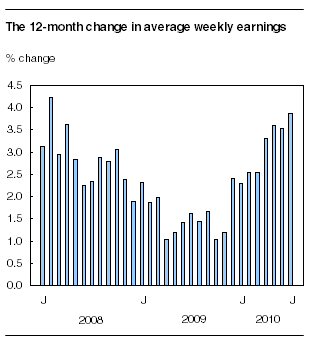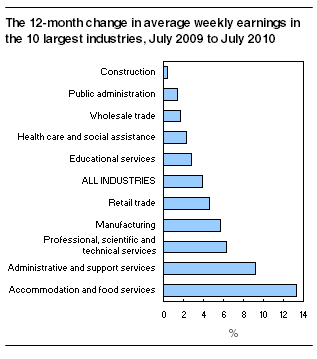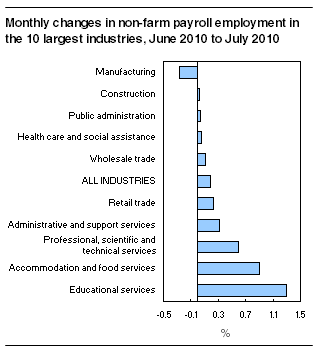Common menu bar links
Payroll employment, earnings and hours
Archived Content
Information identified as archived is provided for reference, research or recordkeeping purposes. It is not subject to the Government of Canada Web Standards and has not been altered or updated since it was archived. Please "contact us" to request a format other than those available.
Related subjects
Between July 2009 and July 2010, the average weekly earnings of non-farm payroll employees rose 3.9% to $855.66. This was the fastest year-over-year increase since February 2008.

In recent months, the pace of growth in earnings has increased. July marked the sixth consecutive month for which the year-over-year increase was at or above 2.5%. For most of 2009, year-over-year earnings growth had been below 2.0%.
Average weekly earnings by industry
Among Canada's largest industrial sectors, growth in average weekly earnings from July 2009 to July 2010 was at or above the national average of 3.9% in accommodation and food services (+13.3%); administration and support, waste management and remediation services (+9.2%); professional, scientific and technical services (+6.3%); manufacturing (+5.7%); and retail trade (+4.6%).
Among the largest industrial sectors, manufacturing has had one of the most notable shifts in average weekly earnings since the fall of 2009. Between July 2008 and October 2009, earnings in this sector had declined by 6.1%. Since October 2009, however, they have increased by 7.3%, more than recovering this loss. Average weekly earnings in manufacturing were $965.90 in July.
Among the larger manufacturing industries, this earnings shift was most notable in paper; machinery; wood products; chemical; and plastics and rubber products manufacturing.
Note to readers
The Survey of Employment, Payrolls and Hours (SEPH) is a business census of non-farm payroll employees. Its key objective is to provide a monthly portrait of the level of earnings and the number of jobs and hours worked by detailed industry at the national, provincial and territorial level.
Statistics Canada also produces employment estimates from its monthly Labour Force Survey (LFS). The LFS is a household survey whose main objective is to divide the working-age population into three mutually exclusive classifications: the employed (including the self-employed), unemployed and not in the labour force. This survey is the official source for the unemployment rate and collects data on the socio-demographic characteristics of all those in the labour market.
Unless otherwise stated, this release presents seasonally adjusted data, which facilitates comparisons by removing the effects of seasonal variations.
All earnings data include overtime pay and exclude businesses that could not be classified to a North American Industrial Classification System code.
Average weekly earnings are derived by dividing total weekly earnings by the number of employees. A number of factors can influence wage changes, such as changes in the level of earnings and/or in the number of payroll employees. Compositional changes over time could also be a factor, such as changes in: the proportions of full-time, part-time, casual, senior and junior employees; the occupational distribution within and across industries; and in the distribution of employment between industries. Such effects may apply differently within different provinces and territories, and over time.
Data on the education sector
Changes in payroll employment in education during the summer months can be affected by changes in payment schedules and school-year calendars. Month-to-month changes should therefore be interpreted with caution, and more attention given to long-term trends.
In September 2008, average weekly earnings in accommodation and food services hit a peak of $338.46. When the economic downturn took hold, however, earnings in this sector began to fall slightly, reaching a low of $325.38 in June 2009 (-3.9%). Since that time, earnings have been on an upward trend to their current level of $369.86 (+13.7%). Earnings have been steadily increasing in accommodation services since June 2009, and in full-service restaurants and limited-service eating places in more recent months. Average weekly earnings in accommodation and food services remain the lowest of all industries, the result of a low hourly wage rate and fewer average hours worked per week.

Average weekly earnings by province
Between July 2009 and July 2010, average weekly earnings increased in most provinces, with growth above the national average in Nova Scotia (+5.4%), Alberta (+5.3%), Saskatchewan (+5.1%) and Ontario (+4.7%). Prince Edward Island (-0.8%) and New Brunswick (-0.1%) were the only two provinces with declines.
Since August 2009, which was the start of the upward trend in payroll employment, average weekly earnings have gone up nationally by 3.8%. Over the same period, earnings rose near or above this national average in six provinces, led by Alberta (+6.2%). The slowest rates of growth were in Prince Edward Island (+0.2%) and New Brunswick (+0.6%).
Non-farm payroll employment by industry
Non-farm payroll employment increased by 0.2% (+27,900) in July from the previous month. With July's gains, the number of payroll employees has increased by 1.6% (+225,500) since August 2009.

The number of people on payrolls in educational services was up 1.3% (+15,100) in July. Changes in payroll employment in education during the summer months can be affected by changes in payment schedules and school-year calendars (see Note to readers). Despite the increase in July, employment in educational services was down 0.8% (-9,500) from a year earlier.
In accommodation and food services, payroll employment increased by 0.9% (+9,600) in July. Job gains were spread out among traveller accommodation, full-service restaurants, limited-service eating places and special food services (such as caterers and street vendors).
In July, the number of jobs in professional, scientific and technical services increased by 0.6% (+4,500). Following its peak in October 2008, employment in this sector declined steadily for one year, after which the trend reversed. Payroll employment in this sector returned in July to a level last seen in February 2009.
Payroll jobs in retail trade increased by 0.2% (+4,200) in July. Gains were primarily in grocery; clothing; and sporting goods, hobby and musical instrument stores. Since August 2009, however, employment in retail trade has declined by 0.1% (-1,800).
Manufacturing employment decreased by 0.3% (-3,900) in July. Since August 2009, employment in this sector has increased by 0.7% (+10,000).
There was little change in construction payroll employment in recent months. However, the number of jobs in this sector has increased by 4.1% (+32,700) since August 2009.
Employment in support activities for mining and oil and gas extraction increased by 4,100 in July. Since hitting a four-year low in May 2009, employment in this industry has risen by 14,700 (+21.5%).
Hours worked and average hours worked by salaried and hourly wage employees
Total hours worked by hourly and salaried employees increased by 0.5% in July, the sixth rise in seven months. Average weekly hours worked by hourly and salaried employees was unchanged at 32.9 hours, and was also the same as average hours worked in July 2009.
Available on CANSIM: tables 281-0023 to 281-0039 and 281-0041 to 281-0046.
Definitions, data sources and methods: survey number 2612.
Detailed industry data, data by size of enterprise based on employment, and other labour market indicators will be available soon in the monthly publication Employment, Earnings and Hours (72-002-X, free).
Data on payroll employment, earnings and hours for August will be released on October 28.
For more information, or to order data, contact Client Services (toll-free 1-866-873-8788; 613-951-4090; labour@statcan.gc.ca). To enquire about the revisions, concepts, methods or data quality of this release, contact Jason Gilmore (613-951-7118), Labour Statistics Division.
Table 1
| Industry group (North American Industry Classification System) | July 2009 | June 2010r | July 2010p | June to July 2010 | July 2009 to July 2010 |
|---|---|---|---|---|---|
| Seasonally adjusted | |||||
| $ current | % change | ||||
| Industrial aggregate | 823.70 | 849.65 | 855.66 | 0.7 | 3.9 |
| Forestry, logging and support | 832.29 | 946.34 | 892.66 | -5.7 | 7.3 |
| Mining and quarrying, and oil and gas extraction | 1,577.51 | 1,699.99 | 1,708.31 | 0.5 | 8.3 |
| Utilities | 1,458.09 | 1,539.58 | 1,610.86 | 4.6 | 10.5 |
| Construction | 1,058.17 | 1,055.43 | 1,062.39 | 0.7 | 0.4 |
| Manufacturing | 913.39 | 939.63 | 965.90 | 2.8 | 5.7 |
| Wholesale trade | 1,022.95 | 1,012.82 | 1,039.87 | 2.7 | 1.7 |
| Retail trade | 476.32 | 500.47 | 498.25 | -0.4 | 4.6 |
| Transportation and warehousing | 877.50 | 879.84 | 906.92 | 3.1 | 3.4 |
| Information and cultural industries | 1,020.51 | 1,046.54 | 1,067.97 | 2.0 | 4.7 |
| Finance and insurance | 1,017.40 | 1,012.00 | 1,034.00 | 2.2 | 1.6 |
| Real estate and rental and leasing | 780.23 | 843.18 | 824.60 | -2.2 | 5.7 |
| Professional, scientific and technical services | 1,100.52 | 1,185.27 | 1,169.62 | -1.3 | 6.3 |
| Management of companies and enterprises | 1,143.54 | 1,219.98 | 1,152.56 | -5.5 | 0.8 |
| Administrative and support, waste management and remediation services | 671.55 | 716.70 | 733.44 | 2.3 | 9.2 |
| Educational services | 909.54 | 960.89 | 935.06 | -2.7 | 2.8 |
| Health care and social assistance | 764.79 | 783.60 | 782.67 | -0.1 | 2.3 |
| Arts, entertainment and recreation | 539.56 | 555.18 | 550.25 | -0.9 | 2.0 |
| Accommodation and food services | 326.34 | 362.39 | 369.86 | 2.1 | 13.3 |
| Other services (excluding public administration) | 726.97 | 729.44 | 711.21 | -2.5 | -2.2 |
| Public administration | 1,083.84 | 1,086.27 | 1,099.22 | 1.2 | 1.4 |
| Provinces and territories | |||||
| Newfoundland and Labrador | 801.68 | 833.67 | 826.03 | -0.9 | 3.0 |
| Prince Edward Island | 698.44 | 709.60 | 693.13 | -2.3 | -0.8 |
| Nova Scotia | 728.61 | 759.63 | 767.84 | 1.1 | 5.4 |
| New Brunswick | 756.67 | 757.97 | 756.22 | -0.2 | -0.1 |
| Quebec | 771.62 | 790.05 | 786.06 | -0.5 | 1.9 |
| Ontario | 846.90 | 876.40 | 886.90 | 1.2 | 4.7 |
| Manitoba | 776.63 | 786.39 | 796.17 | 1.2 | 2.5 |
| Saskatchewan | 803.48 | 842.79 | 844.63 | 0.2 | 5.1 |
| Alberta | 941.88 | 994.21 | 992.26 | -0.2 | 5.3 |
| British Columbia | 797.69 | 813.15 | 828.31 | 1.9 | 3.8 |
| Yukon | 887.97 | 977.49 | 910.20 | -6.9 | 2.5 |
| Northwest Territories¹ | 1,157.87 | 1,193.01 | 1,221.86 | 2.4 | 5.5 |
| Nunavut¹ | 884.71 | 869.63 | 906.34 | 4.2 | 2.4 |
Table 2
| Industry group (North American Industry Classification System) | December 2009 | July 2009 | June 2010r | July 2010p | June to July 2010 | July 2009 to July 2010 | December 2009 to July 2010 |
|---|---|---|---|---|---|---|---|
| Seasonally adjusted | |||||||
| thousands | % change | ||||||
| Industrial aggregate | 14,532.4 | 14,534.8 | 14,673.0 | 14,700.8 | 0.2 | 1.1 | 1.2 |
| Forestry, logging and support | 39.1 | 39.3 | 39.8 | 39.6 | -0.5 | 0.8 | 1.3 |
| Mining and quarrying, and oil and gas extraction | 173.4 | 175.9 | 186.4 | 189.1 | 1.4 | 7.5 | 9.1 |
| Utilities | 117.5 | 117.7 | 118.0 | 118.7 | 0.6 | 0.8 | 1.0 |
| Construction | 805.5 | 786.7 | 820.4 | 820.6 | 0.0 | 4.3 | 1.9 |
| Manufacturing | 1,447.3 | 1,471.1 | 1,467.7 | 1,463.8 | -0.3 | -0.5 | 1.1 |
| Wholesale trade | 723.0 | 725.9 | 728.6 | 729.5 | 0.1 | 0.5 | 0.9 |
| Retail trade | 1,859.9 | 1,863.9 | 1,848.0 | 1,852.2 | 0.2 | -0.6 | -0.4 |
| Transportation and warehousing | 669.7 | 671.7 | 667.9 | 666.1 | -0.3 | -0.8 | -0.5 |
| Information and cultural industries | 313.4 | 321.6 | 311.8 | 310.0 | -0.6 | -3.6 | -1.1 |
| Finance and insurance | 682.6 | 669.3 | 692.0 | 694.0 | 0.3 | 3.7 | 1.7 |
| Real estate and rental and leasing | 245.2 | 240.4 | 238.6 | 240.2 | 0.7 | -0.1 | -2.0 |
| Professional, scientific and technical services | 740.2 | 735.3 | 747.9 | 752.4 | 0.6 | 2.3 | 1.6 |
| Management of companies and enterprises | 117.9 | 116.6 | 106.7 | 107.9 | 1.1 | -7.5 | -8.5 |
| Administrative and support, waste management and remediation services | 719.2 | 719.0 | 730.8 | 733.1 | 0.3 | 2.0 | 1.9 |
| Educational services | 1,161.9 | 1,185.4 | 1,160.8 | 1,175.9 | 1.3 | -0.8 | 1.2 |
| Health care and social assistance | 1,606.5 | 1,582.0 | 1,613.2 | 1,614.2 | 0.1 | 2.0 | 0.5 |
| Arts, entertainment and recreation | 248.8 | 252.9 | 245.4 | 247.6 | 0.9 | -2.1 | -0.5 |
| Accommodation and food services | 1,068.5 | 1,062.4 | 1,058.4 | 1,067.9 | 0.9 | 0.5 | -0.1 |
| Other services (excluding public administration) | 506.2 | 504.9 | 506.9 | 504.6 | -0.5 | -0.1 | -0.3 |
| Public administration | 1,054.7 | 1,041.2 | 1,044.4 | 1,044.7 | 0.0 | 0.3 | -0.9 |
| Provinces and territories | |||||||
| Newfoundland and Labrador | 193.8 | 189.1 | 196.8 | 197.5 | 0.4 | 4.4 | 1.9 |
| Prince Edward Island | 63.6 | 63.1 | 64.5 | 65.3 | 1.2 | 3.5 | 2.7 |
| Nova Scotia | 395.6 | 391.6 | 401.9 | 403.0 | 0.3 | 2.9 | 1.9 |
| New Brunswick | 314.4 | 311.4 | 318.3 | 321.3 | 0.9 | 3.2 | 2.2 |
| Quebec | 3,360.1 | 3,344.0 | 3,365.8 | 3,366.1 | 0.0 | 0.7 | 0.2 |
| Ontario | 5,576.6 | 5,569.9 | 5,633.5 | 5,653.6 | 0.4 | 1.5 | 1.4 |
| Manitoba | 557.4 | 563.8 | 557.7 | 559.1 | 0.3 | -0.8 | 0.3 |
| Saskatchewan | 438.8 | 439.9 | 439.7 | 440.0 | 0.1 | 0.0 | 0.3 |
| Alberta | 1,718.3 | 1,722.1 | 1,740.0 | 1,749.0 | 0.5 | 1.6 | 1.8 |
| British Columbia | 1,876.8 | 1,888.9 | 1,887.1 | 1,896.7 | 0.5 | 0.4 | 1.1 |
| Yukon | 20.1 | 19.0 | 19.8 | 19.3 | -2.5 | 1.6 | -4.0 |
| Northwest Territories¹ | 26.8 | 27.5 | 28.1 | 28.3 | 0.7 | 2.9 | 5.6 |
| Nunavut¹ | 10.2 | 10.5 | 10.9 | 11.1 | 1.8 | 5.7 | 8.8 |

